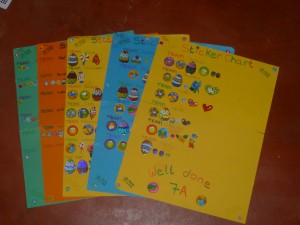For students, having volunteers in their classroom is a new and exciting novelty, and like students anywhere they will try to push the boundaries at the beginning. Below are a few tips that will help you manage the behaviour of the students, particularly in those first few weeks as you settle into the role (some of them may sound very obvious but they are easily forgotten when you are trying to control your class!).
- Start as you mean to go on
– It’s tempting to fool about try get your class smiling and giggling on your first day but two weeks down the line, when you’re struggling to maintain some teacherly authority, you’ll look back and regret it… - Non-verbal Classroom Commands
– right from your first class try using hand gestures or counting techniques to calm down a class that has started to get a bit too loud. Don’t raise your voice, it never works and you just loose your voice. Examples are placing your finger to your lips and giving a thumbs-up to those children that notice and copy you; quietly count down from 5 (using your fingers with your hand held high) and then use a palm down gesture to signify sitting down. Do a silent ‘head, shoulders, knees and toes’ – it’s amazing how quickly you’ll have a silent class room. - Learn student’s names
– this may be slightly daunting at first, but there is a lot to be said about learning the names of your students. Perhaps the first activity you do with a new class is get them to make and decorate a label of their ‘English name’ that they put on their desk in front of them. - Classroom rules
– define rules in your classroom from day one, for example ‘raise your hand to speak’ or ‘only speak in English’, and reiterate these at the beginning of each lesson, it might be useful to write them on the board each lesson to remind students at the start of every lesson. - Clap, copy, listen
– it may be useful to have an approach to get the students to be quiet when it is noisy in the classroom, having something that is interactive can help engage students. One example is clapping a rhythm and the students have to clap it back to you and then be quiet. - Lesson plan
– spend time planning your lessons and let students to know what the plan is for the lesson so they don’t get restless and can see progression through tasks. It is best to write this in steps of 1,2,3 on the board. For example 1 – song, 2 – group work, 3 – game. NB: if 3 is a game you would be surprised how quickly the group work will be done – but it is a good motivation!! - Feedback
– always be positive when teaching your lesson, encourage children to speak in the classroom by giving feedback at the end of their speech. It takes a lot of confidence for students to stand up in front of their peers and speak in a different language so verbal rewards are a good way to encourage students. - Rewards/awards
– quite often punishment is more prominent in schools than rewards, introducing simple rewards like a ‘Student of the Week’ certificate (you can make this easily!) can really encourage students to learn English, especially if they do not normally get awards. When giving out the award state clearly why that particular student received the award that week, it may simply be because they were quiet and listened throughout all your lessons that week. Giving an award can encourage other students in the class to copy the behaviour of that student. You could also put up a good piece of work in a polly pocket each day – kids love to see their work on show. - Managing large classes
– when faced with a class of forty students or more it is likely to be very daunting and hard for discussion and speech to take place while having control of the rest of the class. One way to overcome this is to split your class in to groups, encouraging students to interact with students in their class who they may not normally have much contact with (it is better if you choose the groups to avoid friends staying together).
This can be combined with the introduction of a sticker or point chart, where you can give a ‘point’ to a group each lesson for the group that worked the hardest, was the quietest, spoke the most English etc. It is often hard to engage students when other students are talking, so you could ask the listeners questions after the speaker has finished about the content of their speech and give points to groups who have got the most answers right.





Comments are closed.